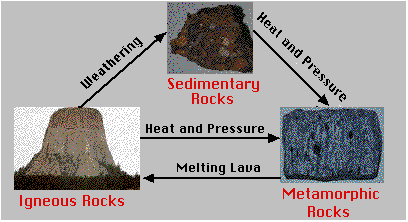SCIENCE REVIEW
CHAPTER 4
Name
_____________________
Write a definition for the following terms.
1. Rock-
Rocks are made of two or more different minerals that have been 1) cemented together, or 2) squeezed and heated together, or 3) melted and cooled together. Rocks make up the majority of the Earth's crust. One of the most common rock is granite.
2. Mineral- A mineral is a solid material, made of one substance, that occurs naturally on Earth.
Most of the common minerals are made of crystals. A Crystal is a solid formed by a repeating, three-dimensional pattern of atoms, ions, or molecules and having fixed distances between the different parts.
3. Weathering-
The break down of rock by wind, water, or ice into smaller pieces.
4. Igneous rocks-Igneous rocks start as magma. The magma (molten rock under the surface) and lava (molten rock on the surface) hardens into igneous rock.
5. Sedimentary rocks- Sedimentary rocks are formed from the breaking apart of other rocks (igneous, metamorphic, or sedimentary rocks) and the cementation, compaction and recrystallization of these broken pieces of rock.
6. Metamorphic rocks- Metamorphic rocks form from heat and pressure changing the original or parent rock into a completely new rock. The parent rock can be either sedimentary, igneous, or even another metamorphic rock.
7. Draw a diagram and describe the rock cycle-

8. Name the most common rock found on the surface of the Earth.
One of the most common rock is granite.
9-12. Name the four minerals that make up granite.
The four minerals that make up granite are feldspar, quartz, mica, and hornblende.
13. Describe what a property of a mineral is.
A mineral is a solid material, made of one substance, that occurs naturally on Earth.
14-21. Match the following igneous terms with its corresponding definition.
14. __H__Sill a. An intrusive igneous body that runs through an existing layer of rock.
15. __ A __Dike b. A very large intrusive igneous body that is larger than 100 square miles.
16. __ B __Batholith c. An igneous rock that is formed under the surface of the Earth.
17. __ G __Laccolith d. Molten rock under the surface of the Earth.
18. __ C __Intrusive e. Molten rock on the surface of the Earth.
19. __ F __Extrusive F. An igneous rock that is formed on the surface of the Earth.
20. __ D __Magma g. A small intrusive igneous body.
21. __ E __Lava h. An intrusive igneous body that runs parallel with existing rock layers.
22- 28. Match the following terms with its corresponding definition.
22. _ C __Metallic a. A test to determine the true color of a mineral.
23. _ F __Non-metallic b. A property that describes how a mineral breaks into flat planes.
24. __ A __Streak c. A mineral that conducts electricity.
25. __ D __Hardness d. A property of a mineral that is measured by the Mohs scale.
26. __ B __Cleavage e. A property of a mineral that measures how it reflects light.
27. __ E __Luster f. A mineral that does not conduct electricity.
28-42 Write the correct term rock or mineral after each word below.
Pumice rock
Talc___ mineral ___
Gabbro___ rock ________
Granite__ Rock ___
Magnetite__ mineral ________
Hornblende_ mineral ___
Hematite___ mineral ________
Mica______ mineral ___
Obsidian___ Rock _____
Quartz____ mineral ___
Galena___ mineral _________
Feldspar___ mineral ______
Basalt____ Rock _____
Calcite____ mineral _____
Rhyolite___ Rock ________